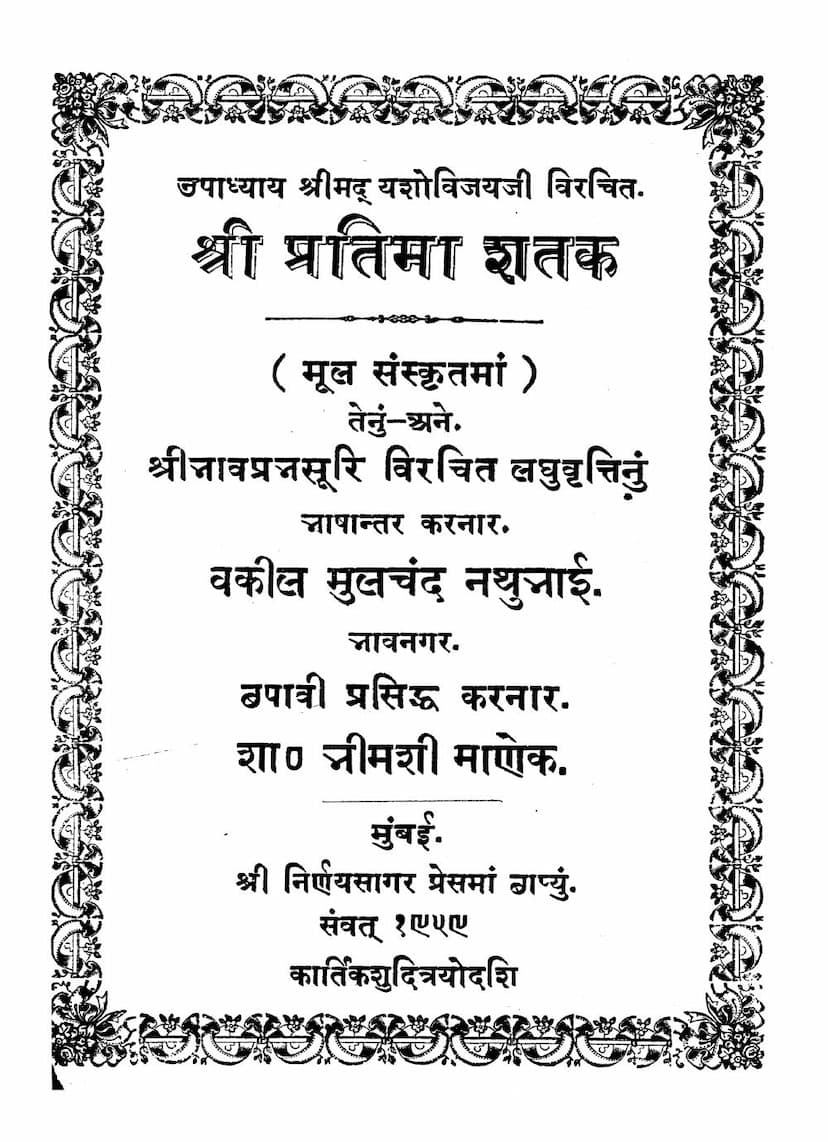Pratima Shatak
Added to library: September 2, 2025

Summary
The following is a comprehensive summary of the Jain text "Pratima Shatak" by Yashovijay Maharaj, Bhavprabhsuri, and Mulchand Nathubhai Vakil, based on the provided pages and catalog link:
Title: Pratima Shatak (A Century of Images) Author: Acharya Yashovijayji, with commentary (Laghu Vritti) by Acharya Bhavprabhsuri and translation by Vakil Mulchand Nathubhai. Publisher: Shravak Bhimsinh Manek, Mumbai. Published at Nirnaysagar Press, Samvat 1850 (Kartik Sud Triyodashi). Catalog Link: https://jainqq.org/explore/022204/1
Overall Purpose and Context:
The "Pratima Shatak" is presented as a significant work within the vast collection of writings by the esteemed Jain philosopher and logician, Upadhyay Shrimad Yashovijayji. The book addresses a crucial and often debated topic in Jainism: the veneration and significance of Pratimas (images of Tirthankaras) and Jinnalayas (temples). The author's intention, as explained in the preface, is not to condemn those who oppose image worship (referred to as "Dundiya" or "Lumpaka" followers, which likely refers to the Taranapanthi or similar groups), but rather to educate them and guide them towards the righteous path of Jainism.
Core Arguments and Themes:
-
Correction of Misconceptions: The preface highlights that at first glance, the text might appear to be a harsh criticism of those who oppose image worship. However, upon deeper study and understanding of the scriptures, it becomes clear that the author's harsh words are intended as "bitter medicine" that ultimately leads to beneficial results. The author's intent is to save beings from endless cycles of birth and death (samsara) by encouraging them to follow the pure path.
-
Logical Reasoning and Examples: The text emphasizes the use of logical reasoning (hetu), arguments (yukti), and examples (drishtanta) throughout its verses. This is intended to showcase the author's profound logical prowess and to convince the reader through rational discourse.
-
Defense of Pratima Worship and Jinnalayas:
- Purpose of Pratimas: The primary purpose of establishing the images of Tirthankaras is to remember and honor the immense benefits received from their teachings, which continue to guide beings towards liberation. Just as worldly individuals honor kings, ministers, or wealthy patrons by worshipping their effigies or images as a duty, Jains should honor the Tirthankaras who guide them out of the cycle of suffering.
- Benefits of Pratima Worship: The text argues that worshipping and venerating Pratimas leads to spiritual benefit. It connects the concept of "Rasa" (aesthetic sentiment) to spiritual development, differentiating between the nine materialistic "Rasas" and the one spiritual "Shanta Rasa" (serene sentiment). The image of a Tirthankara is seen as a means to attain the highest state of Shanta Rasa, leading to the development of virtues like humility, gentleness, straightforwardness, and contentment, ultimately paving the path to liberation.
- Against Opposition: The text argues that those who reject Pratima worship and temples based on their own interpretations, without scriptural basis or logical reasoning, are mistaken. It suggests that such opposition is rooted in ignorance and potentially in misunderstandings spread by those who promote flawed arguments about violence in idol making and worship.
-
Critique of Opponents (Lumpakas/Dundiyas): The preface suggests that in Yashovijayji's time, the "Dundiya" sect, through their influential teachings, may have misled less intelligent individuals into believing that creating and worshipping Pratimas and Jinnalayas involves violence. The author's work aims to bring these misled individuals back to the true path.
-
Importance of Internal Devotion and Correct Practice: The text stresses the importance of "Aachran" (conduct) in devotion, emphasizing qualities like unalloyed devotion (ananya), unwavering faith (adhridha), and sustained effort (akhed). It critiques practices that disrupt communal harmony or cause offense to others during worship. The analogy of people being orderly at a train station to get tickets, facilitated by police presence, is used to emphasize the need for discipline and respect for others' rights while engaging in religious practices.
-
Theological and Philosophical Underpinnings:
- Naya (Standpoints): The text discusses the importance of understanding different Nayas (philosophical standpoints) like Nama, Sthapana, Dravya, and Bhava Naya, and how they relate to understanding the Tirthankara and their images. It argues that all four Nayas are essential for a complete understanding.
- Scriptural Authority: The text frequently refers to Jain scriptures like the Bhagavati Sutra, Mahanishith Sutra, and others to support its arguments, indicating a strong foundation in the established Jain canon.
- Devotional Practices: The text discusses various forms of devotion, including chanting (Stotras), bowing (Vandan), and offerings (Pujan), and their spiritual significance. It even mentions the worship of Tirthankara images by celestial beings (deities) and sages (Charanas).
-
Specific Debates Addressed (Implied by Table of Contents): The extensive table of contents suggests the book delves into detailed refutations of various arguments against image worship. This includes:
- The meaning of "Chaitya" and its interpretation by opponents.
- The role of deities in worship and their relationship with Tirthankaras.
- The nature of worship (Savadh vs. Niravadh).
- The difference between monastic and lay devotee practices.
- The concept of "Pratishtha" (consecration) of images.
- The potential for violence in rituals and how it is addressed in Jain philosophy.
- The interpretation of key Jain scriptures concerning these topics.
Key Figures Mentioned:
- Upadhyay Shrimad Yashovijayji: The primary author, a renowned logician and scholar.
- Acharya Bhavprabhsuri: The commentator whose "Laghu Vritti" (short commentary) is translated.
- Mulchand Nathubhai Vakil: The translator.
- Tirthankaras (e.g., Rishabhdev, Parshvanath, Mahavir): Revered figures whose images are the subject of veneration.
- Deities and Sages: Mentioned as devotees of Tirthankara images.
- Dundiya/Lumpaka Followers: Those who oppose image worship.
Significance:
The "Pratima Shatak" is a significant contribution to Jain theological and philosophical discourse. It provides a reasoned and scripturally supported defense of image worship and temple construction, which are integral practices for many Jains. By employing sophisticated logical arguments and addressing the counter-arguments of opposing groups, the text aims to clarify doctrine and promote the correct understanding of these vital aspects of Jainism.